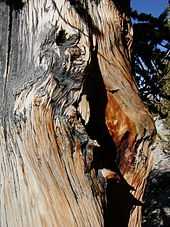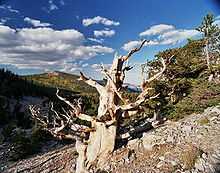Bristlecone pine
| Bristlecone pine | |
|---|---|
 | |
| A Great Basin bristlecone pine grove | |
| Scientific classification | |
| Kingdom: | Plantae |
| Division: | Pinophyta |
| Class: | Pinopsida |
| Order: | Pinales |
| Family: | Pinaceae |
| Genus: | Pinus |
| Subgenus: | Ducampopinus |
| Section: | Balfourianae |
| Species | |
The bristlecone pines are three species of pine trees (family Pinaceae, genus Pinus, subsection Balfourianae) believed to live longer than any other known organism: over 5,000 years. Bristlecones grow in scattered subalpine groves at high altitude in arid regions of the Western United States. The name comes from the prickles on the female cones.[1]
Species and range
There are three closely related species of bristlecone pine:
- Rocky Mountains bristlecone pine Pinus aristata in Colorado, New Mexico and Arizona
- Great Basin bristlecone pine Pinus longaeva in Utah, Nevada and eastern California
- Foxtail pine Pinus balfouriana in California and one isolated population in southern Oregon.[2]

At least some of the three species can hybridize in cultivation, but the ranges of wild populations do not overlap. The Colorado River and Green River produces a 160-mile (260 km) gap between the ranges of P. longaeva and P. aristata and the northern Owens Valley provides a 20-mile (30 km) gap between the ranges of P. longaeva and P. balfouriana.[3]
Description
Bristlecone pines grow in isolated groves just below the tree line, between 5,600 and 11,200 ft (1,700 and 3,400 m) elevation on dolomitic soils.[1] Because of cold temperatures, dry soils, high winds, and short growing seasons, the trees grow very slowly. Even the tree's needles, which grow in bunches of five, can remain on the tree for forty years, which gives the tree's terminal branches the unique appearance of a long bottle brush.

The wood is very dense and resinous, and thus resistant to invasion by insects, fungi, and other potential pests. The tree's longevity is due in part to the wood's extreme durability. While other species of trees that grow nearby suffer rot, bare bristlecone pines can endure, even after death, often still standing on their roots, for many centuries. Rather than rot, exposed wood, on living and dead trees, erodes like stone due to wind, rain, and freezing, which creates unusual forms and shapes.
The bristlecone pine has an intrinsically low rate of reproduction and regeneration, and it is thought that under present climatic and environmental conditions the rate of regeneration may be insufficient to sustain its population.[4] The species are on the International Union for Conservation of Nature (IUCN) red list.[4] Bristlecone pines are protected in a number of national parks such as the Ancient Bristlecone Pine Forest in the White Mountains of California and the Great Basin National Park in Nevada,[5][6] where cutting or gathering wood is prohibited.[5]
The green pine needles give the twisted branches a bottle-brush appearance. The name bristlecone pine refers to the dark purple female cones that bear incurved prickles on their surface.[1][6] These ancient trees have a fittingly gnarled and stunted appearance, especially those found at high altitudes,[7] and have reddish-brown bark with deep fissures.[8] As the tree ages, much of its vascular cambium layer may die. In very old specimens, often only a narrow strip of living tissue connects the roots to a handful of live branches.
Oldest living organisms

The bristlecone pines are the oldest single living organisms known (though some plants form clonal colonies which may be many times older). The oldest bristlecone pines are single plants that have been alive for a little more than 5,000 years. These very old trees are of great importance in dendrochronology or tree-ring dating.
A specimen of Pinus longaeva located in the White Mountains of California was measured by Tom Harlan to be 5,062 years old in 2012.[9] The identity of the specimen is being kept secret by Harlan. This is the oldest known tree in North America, and the oldest known individual tree in the world, although a clonal individual, nicknamed "Old Tjikko", a Norway spruce in Sweden is 9,550 years old.[10][11]
The other two species, Pinus balfouriana and Pinus aristata are also long-lived, though not to the extreme extent of P. longaeva; specimens of both have been measured or estimated to be up to 3,000 years old.[12]
The Rocky Mountain population is severely threatened by an introduced fungal disease known as white pine blister rust, and by pine beetles.[13]
See also
- List of long-living organisms
References
This article incorporates text from the ARKive fact-file "Bristlecone pine" under the Creative Commons Attribution-ShareAlike 3.0 Unported License and the GFDL.
- ↑ 1.0 1.1 1.2 Bristlecone pine media at ARKive
- ↑ Lanner, RM (2007). The Bristlecone Book. Mountain Press. p. 14. ISBN 978-0878425389.
- ↑ Fryer, Janet L (2004). "Pinus longaeva". U.S. Department of Agriculture, Forest Service, Rocky Mountain Research Station, Fire Sciences Laboratory.
- ↑ 4.0 4.1 "IUCN Red List". IUCN. Retrieved 30 July 2011.
- ↑ 5.0 5.1 "Global Trees Campaign". March 2008. Retrieved 30 July 2011.
- ↑ 6.0 6.1 "The Ancient Bristlecone Pine". August 2003. Retrieved 30 July 2011.
- ↑ "Pinus longaeva". March 2008. Retrieved 30 July 2011.
- ↑ "The Gymnosperm Database". March 2008. Retrieved 30 July 2011.
- ↑ "Oldlist". Rocky Mountain Tree Ring Research. Retrieved 2013-01-08.
- ↑ World’s oldest living tree discovered in Sweden (Umeå University Press Release, 16 April 2008)
- ↑ Owen, James. "Oldest Living Tree Found in Sweden". National Geographic. Retrieved 2008-05-06.
- ↑ Bain, G. Donald (2001). "Explore the Methuselah Grove". NOVA Online: Methuselah Tree. PBS.
- ↑ Robbins, Jim (2010-09-27). "Old Trees May Soon Meet Their Match". The New York Times.
Further reading
- Bailey, D. K. 1970. Phytogeography and taxonomy of Pinus subsection Balfourianae. Ann. Missouri Bot. Gard. 57: 210-249.
- Richardson, D. M. (ed.). 1998. Ecology and Biogeography of Pinus. Cambridge University Press, Cambridge. 530 p. ISBN 0-521-55176-5.
External links
- Arboretum de Villardebelle Images of cones (scroll to bottom of page)
- Gymnosperm Database - Pinus aristata
- Gymnosperm Database - Pinus longaeva
- Gymnosperm Database - Pinus balfouriana
- Prometheus: The Martyred One
- OpenRoad.TV (video story about the Ancient Bristlecone Pines)